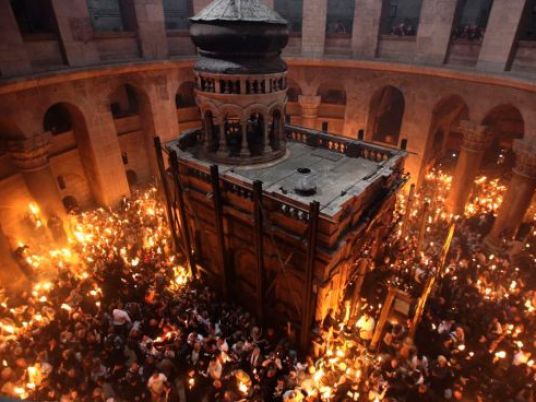
In the corner of a pristine Jerusalem church, the tomb of Marie Alphonsine Ghattas looks out over just a small part of her legacy, days ahead of her canonisation in Rome.
A box under an altar holds her earthly remains, and Catholic worshippers have already scribbled prayers in Arabic to "Saint Marie Alphonsine", in a notebook placed next to her tomb in the chapel.
Ghattas and Mariam Bawardy, another nun born in the 19th century, are on Sunday to become the first modern-day Palestinian saints, at a ceremony Pope Francis will lead at the Vatican.
The canonisation has Palestinians buzzing with excitement, and president Mahmud Abbas is travelling to Rome to attend.
The Vatican said Wednesday it was preparing to sign its first accord with Palestine, two years after recognising it as a state, but the canonisation comes without political baggage.
Ghattas, through her focus on women's education and community work, left behind a network of convents, schools and religious centres — a more palpable legacy than Bawardy, who lives on more through the memory of her tough and mysterious life.
The west Jerusalem church — circular with stain-glass windows featuring an image of Ghattas — is housed in a convent of the Rosary Sisters, the order that she founded for Arab women in 1880.
It is one of many Rosary Sisters institutions across the Palestinian territories, Jordan, Egypt, Lebanon and even further afield.
"Her message was to educate Arab women and girls," Sister Hortance Nakhleh said, sitting in the church of the Mamilla Monastery, below a large poster imploring their founder to "pray for us".
"The period she lived in was a difficult one for Arab women, and their education was very limited," Nakhleh said.
"This daughter of Jerusalem existed to educate Arab girls and mothers."
Ghattas was born in 1847 in the Holy City during its rule by the Ottoman Empire, and died there during the British mandate period in 1927.
– Champion of women's education –
The institutions she left behind have been busy with preparations for the special day.
At the Rosary Sisters girls' secondary school in east Jerusalem, pupils' artwork and drawings of Ghattas adorn noticeboards, with potted histories of her life printed out in Arabic.
"It's a great thing, we're really proud as girls studying at the Rosary Sisters school," said 16-year-old pupil Mervat Dabebneh.
The girls have learned the story of the saint, and say they take inspiration from her life.
For sainthood, the candidate must have lived a holy life, as determined by the Catholic Church, and must usually have at least two miracles to their name, attributable to prayers made to them posthumously.
A miracle that led to Ghattas's canonisation was the resuscitation of a Palestinian engineer in 2009, who was electrocuted and suffered a heart attack, but regained consciousness two days later after relatives prayed to her.
During her life, Ghattas is said to have seen the Virgin Mary in several apparitions, and nuns talk of miracles she performed then, including saving a girl who had fallen down a well by tossing her rosary into the water.
– Mysticism and suffering –
Ghattas was born into a devoted Christian family and spent her life in the Holy Land, working among the poor and setting up her order and the schools that followed.
Galilee native Mariam Bawardy lived a more troubled, short but mysterious life, and leaves behind a more modest physical presence.
The Bethlehem monastery where she is buried features a small chapel with a glass case containing her arm bone.
The church is impressively positioned, however, looking out from a hilltop across the town of Jesus's birth in the southern West Bank.
After becoming a nun of the Carmelite order, Bawardy helped found the Carmelite Monastery in Bethlehem, and died there in 1878, aged 33.
She left behind no schools, but will be venerated.
"Bawardy's life was dedicated to prayer, and working inside the monastery," Sister Feryal Karraa said, sitting in a spartan office adjoining the chapel.
Karraa recounted the miracle leading to Bawardy's canonisation — a Palestinian infant born almost strangled by his umbilical cord was given two days to live, but survived after prayers to the saint, and is now a healthy schoolboy.
Bawardy's own existence was one of suffering.
Orphaned at a young age and illiterate, an angry would-be suitor cut her throat when she refused to convert to Islam, but a mysterious "nun in blue" is said to have saved her life, the Carmelite order's website says.
She travelled to France to become a nun, then to India to help set up a monastery there, and eventually settled in Bethlehem.
